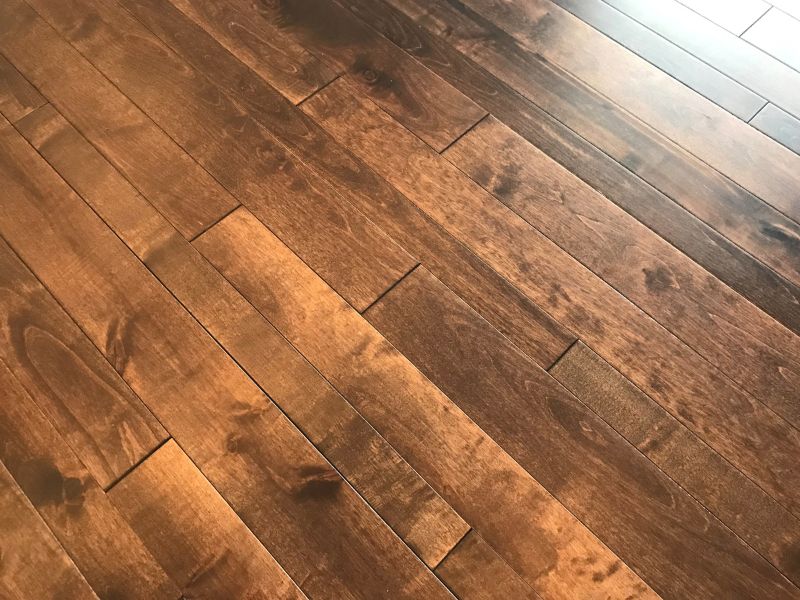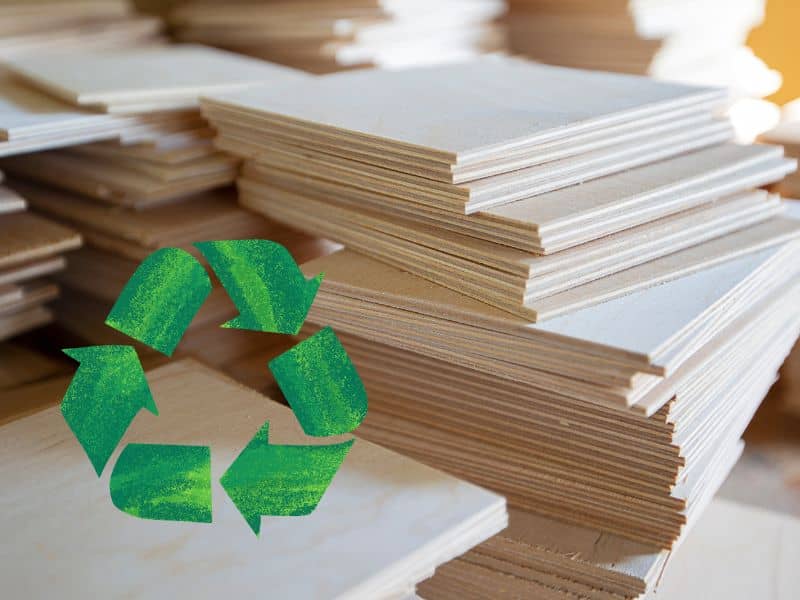What Is Engineered Wood (VS Reclaimed Wood): Key Differences

Wood has been a go-to building material for centuries. However, with the rise of environmental concerns and the demand for sustainable options, traditional wood has become a more difficult choice.
Instead, engineered and reclaimed woods have emerged as eco-friendly alternatives promoting sustainable construction.
Now, what is engineered wood, and how does it differ from reclaimed wood?
Engineered wood, also known as manufactured board, is wood made by binding layers of wood fibers, polymers, or veneers with adhesives under high pressure. On the other hand, reclaimed wood is wood salvaged from barns, old buildings, and other structures and reprocessed for other uses.
In the rest of this article, I’ll discuss the key differences between engineered wood and reclaimed wood.
This comparison will help you decide which type of wood is best for your project in terms of cost, lifespan, and appearance. Stay tuned!
What Is Engineered Wood Vs. Reclaimed Wood: Head-to-Head Comparison
Based on their key metrics, this section will directly compare engineered and reclaimed wood.
Cost

Cost is among the metrics where engineered wood and reclaimed wood differ quite a bit.
While engineered wood costs between $3 and $9 per square foot, reclaimed wood costs between $10 and $12 per square foot.
Reclaimed wood is much more expensive than engineered wood because it requires much more handling and is often stored for a long time.
For example, reclaimed wood needs any nails removed and could require milling before being sold. If it is an unpopular size, it might have to be stored for quite a while until someone buys it, which also costs money.
Durability
Another critical difference between the two is their durability. Engineered wood has an average lifespan of 25 to 30 years.
It’s impossible to be specific about reclaimed wood’s lifespan because it depends on its source, whether it has been treated with preservative chemicals, and how long it has been used on the previous structure.
One benefit of using reclaimed wood is that it is well-seasoned. As a result, it’s unlikely to warp or twist as it ages and shouldn’t develop shocks in its surface, unlike new wood.
Appearance

Engineered wood resembles most hardwood surfaces because of the top veneer made from hardwoods.
It has grain patterns that match those of hardwoods. Consequently, differentiating between engineered and solid wood once installed, say on a floor, can be challenging. An easy way around this is to check if the wood has underlying core and backing layers.
Reclaimed wood, on the other hand, features a rustic appearance. Its textured and aged appearance gives it a charming style that adds a touch of personality to any space.
Noise Insulation

Engineered wood has excellent sound insulation since it incorporates many layers and is quite dense. Each layer acts as a noise barrier that reduces the amount of sound that passes through.
On the other hand, reclaimed wood is less efficient than its engineered counterpart in noise insulation.
Salvaged wood may have some fractures or spaces through which sound may pass. Moreover, due to the use of this wood on a different structure, its fibers may be weak, allowing sound to penetrate.
Maintenance Requirements
Engineered wood requires more maintenance than reclaimed wood due to the incorporation of many wood components.
The many layers in some types of engineered wood, such as plywood, expose it to warping, bending, and forming gaps. This is why these woods require maintenance, like applying lacquer protection and maintenance oils.
Reclaimed wood, on the other hand, doesn’t require regular maintenance. However, you’ll have to keep it clean and moisture-free to ensure it lasts as long as possible.
If your reclaimed wood hasn’t been treated, you can maintain it by applying a mixture of white vinegar, olive oil, and water. Proprietary formulations are also available from specialist firms.
Environmental Impact

Engineered wood fosters sustainable building because its manufacturing uses less energy than concrete and steel. Moreover, since wood sequesters carbon, it’s essential in reducing the carbon emitted from construction projects.
One downside of engineered wood is the use of formaldehyde as a binder. Formaldehyde is a carcinogenic component that pollutes indoor air.
Reclaimed wood beats engineered wood in terms of having a low environmental impact. Besides being finished with fewer chemicals, reclaimed wood requires less processing, lowering greenhouse gas emissions.
What’s more, unlike engineered wood, reclaimed wood doesn’t need any virgin raw materials to manufacture and diverts useful wood from landfill.
Sanding and Refinishing
Engineered wood is easy to sand and refinish. However, remember that the more times you sand it, the thinner the surface veneer will get, exposing the inner layers. Therefore, you can’t refinish engineered wood multiple times.
On the other hand, reclaimed wood can be sanded and refinished multiple times without losing its charm or strength.
Stability

Due to engineered wood containing several layers, and the fact that each layer is oriented at 90° to adjacent layers, engineered wood has more stability than reclaimed wood. The many layers work together to respond well to atmospheric changes like humidity and temperature.
Reclaimed wood is fairly stable because it has experienced different weather extremes and is well-seasoned. As a result, it’s able to withstand usual wear and tear.
The table below summarizes the comparison between engineered wood and reclaimed wood:
| Comparison | Engineered Wood | Reclaimed Wood |
| Lifespan | 25-30 years | Depends on previous use |
| Cost | $3-$9 | $10-$12 |
| Noise insulation | Excellent | Fair |
| Appearance | Layered hardwood grains | Rustic |
| Maintenance requirement | High | Low |
| Environmental impact | Less energy Carbon sequestration Reduced greenhouse emissions | Fewer chemicals No virgin raw material required Less processing |
| Sanding, refinishing | Not advisable | Possible |
| Stability | High | Fair |
| Installation method | Gluing, stapling, nailing, and floating | Gluing and nailing |
What Is the Main Difference Between Wood and Engineered Wood?
The main difference between wood and engineered wood is that the latter is artificial and consists of the wear, core, and backing layers for stability. Wood is made up of a single solid piece of lumber.
Engineered wood is designed to be more stable than solid wood, making it ideal for areas with high humidity or extreme temperature fluctuations. Unlike solid wood, engineered wood can’t be refinished to extend its lifespan.
What Is Special About Engineered Wood?
The special thing about engineered wood is that despite resembling hardwood, it’s highly stable and suitable for areas with temperature and moisture fluctuations.
Also, engineered wood has better sound insulation than solid wood, making it ideal for noisy areas.
What Are the Advantages and Disadvantages of Engineered Woods?

The following are the advantages and disadvantages of engineered wood:
Advantages
- Cost-effective: Engineered wood costs between $3 and $9 per square foot. On the other hand, solid wood costs between $4.50 and $20, depending on tree species.
- Environmentally friendly: Engineered wood uses less natural wood; thus, it plays a role in preserving trees. The manufacturing process also consumes less energy.
- Uniformity: Since engineered woods are manufactured, they have a more uniform texture and density. Consequently, they are easier to work with.
- Variety: These woods come in different colors, finishes, and sizes. As a result, they are ideal for myriad applications.
Disadvantages
- Unsuitable for refinishing: Refinishing engineered wood multiple times to extend its lifespan is impossible because the process makes the veneers thinner and will eventually wear through them.
- Difficult to repair: The multiple layers of engineered wood make repairs difficult. There are higher chances of separating the layers when doing repairs.
- Low value: Unlike solid wood, engineered wood has a lower resale value due to its artificial nature.
- Lifespan: Since engineered woods are made of multiple layers, they have a shorter lifespan than solid wood. Furthermore, it’s not recommended to refinish these woods.
- VOCs: Engineered wood contains formaldehyde, a known carcinogenic VOC that endangers human life.
Why Is Reclaimed Wood Stronger?
Reclaimed wood is stronger because it has gone through the aging process. Wood loses more moisture as it ages, gaining strength in the process.
Wood also becomes denser as it loses more moisture. Denser woods are stronger, thus, making reclaimed wood a better choice for high-traffic areas.
The strength of reclaimed wood also makes it ideal for furniture and other pieces that require more durability.
How Long Does Engineered Wood Last?
Engineered wood lasts between 25 and 30 years, depending on how well it’s maintained. To increase the longevity of engineered wood, it’s recommended to keep humidity and temperature levels in your home within the recommended range.
Moreover, you should avoid sanding or refinishing engineered wood.
Does Water Damage Engineered Hardwood Floors?

Water can damage engineered hardwood floors if it penetrates into the core layer. Since this layer is not water-resistant, it can cause the grains to swell and separate.
Therefore, cleaning spills immediately and using mats at entrances to keep dirt and water out of your home is essential.
Furthermore, you should mop engineered flooring regularly with a pH-neutral cleaner like a dishwashing liquid for maximum protection.
Does Engineered Wood Fade in Sunlight?
Engineered wood fades in sunlight due to ultraviolet rays. These rays break down the wood’s chemical bonds, resulting in the wood aging faster and fading in color.
Applying a UV-resistant finish or stain is an excellent way to prevent fading. Alternatively, you can buy light-colored engineered wood since it doesn’t fade as much as its dark-colored counterparts.
Which Is Better, Engineered Wood or Solid Wood?
Engineered wood and solid woods are better for different conditions. While engineered wood is better for high-moisture environments, solid wood is better for durability.
Moreover, engineered wood is better for those on a tight budget since it costs less than solid wood. On the other hand, solid woods are pricier but have a higher resale value.
Is Engineered Wood Good Quality?
Engineered wood is good quality because it has multiple layers fused with strong adhesives.
Additionally, the finishes applied to these woods are long-lasting and remain bright for years.
Does Engineered Wood Scratch Easily?

Engineered wood scratches easily because the wear layer is made from hardwood veneer. Like any other hardwood, the veneer is susceptible to scratches and dents from traffic.
You can use area rugs and mats with non-staining backing to minimize scratches in high-traffic areas.
Final Thoughts
Both engineered wood and reclaimed wood have their advantages and disadvantages.
While reclaimed wood is stronger but more expensive, engineered wood is cheaper but less durable.
Your choice should depend on the environment, usage, and budget. Furthermore, maintenance is essential for both types of wood to ensure longevity.
Now that you know the key differences between engineered and reclaimed wood, check out this article for examples of sustainable construction.







